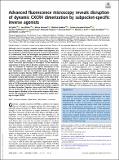Files in this item
Advanced fluorescence microscopy reveals disruption of dynamic CXCR4 dimerization by subpocket-specific inverse agonists
Item metadata
| dc.contributor.author | Işbilir, Ali | |
| dc.contributor.author | Möller, Jan | |
| dc.contributor.author | Arimont, Marta | |
| dc.contributor.author | Bobkov, Vladimir | |
| dc.contributor.author | Perpiñá-Viciano, Cristina | |
| dc.contributor.author | Hoffmann, Carsten | |
| dc.contributor.author | Inoue, Asuka | |
| dc.contributor.author | Heukers, Raimond | |
| dc.contributor.author | de Graaf, Chris | |
| dc.contributor.author | Smit, Martine J. | |
| dc.contributor.author | Annibale, Paolo | |
| dc.contributor.author | Lohse, Martin J. | |
| dc.date.accessioned | 2022-01-13T17:30:03Z | |
| dc.date.available | 2022-01-13T17:30:03Z | |
| dc.date.issued | 2020-11-17 | |
| dc.identifier | 277342165 | |
| dc.identifier | e79da2b8-ad31-4214-81aa-72dc0f284867 | |
| dc.identifier | 85096357712 | |
| dc.identifier | 33148803 | |
| dc.identifier.citation | Işbilir , A , Möller , J , Arimont , M , Bobkov , V , Perpiñá-Viciano , C , Hoffmann , C , Inoue , A , Heukers , R , de Graaf , C , Smit , M J , Annibale , P & Lohse , M J 2020 , ' Advanced fluorescence microscopy reveals disruption of dynamic CXCR4 dimerization by subpocket-specific inverse agonists ' , Proceedings of the National Academy of Sciences of the United States of America , vol. 117 , no. 46 , pp. 29144-29154 . https://doi.org/10.1073/pnas.2013319117 | en |
| dc.identifier.issn | 0027-8424 | |
| dc.identifier.other | ORCID: /0000-0003-3208-5347/work/105957261 | |
| dc.identifier.uri | https://hdl.handle.net/10023/24657 | |
| dc.description | Funding: This research was funded by European Union’s Horizon2020 Marie Skłodowska-Curie Actions (MSCA) Program under Grant Agreement 641833 (ONCORNET) and European Cooperation in Science and Technology (COST) Action CA18133 European Research Network on Signal Transduction (ERNEST). A. Inoue was funded by the Leading Advanced Projects for Medical Innovation (LEAP) JP19gm0010004 from the Japan Agency for Medical Research and Development. | en |
| dc.description.abstract | Although class A G protein−coupled receptors (GPCRs) can function as monomers, many of them form dimers and oligomers, but the mechanisms and functional relevance of such oligomerization is ill understood. Here, we investigate this problem for the CXC chemokine receptor 4 (CXCR4), a GPCR that regulates immune and hematopoietic cell trafficking, and a major drug target in cancer therapy. We combine single-molecule microscopy and fluorescence fluctuation spectroscopy to investigate CXCR4 membrane organization in living cells at densities ranging from a few molecules to hundreds of molecules per square micrometer of the plasma membrane. We observe that CXCR4 forms dynamic, transient homodimers, and that the monomer−dimer equilibrium is governed by receptor density. CXCR4 inverse agonists that bind to the receptor minor pocket inhibit CXCR4 constitutive activity and abolish receptor dimerization. A mutation in the minor binding pocket reduced the dimer-disrupting ability of these ligands. In addition, mutating critical residues in the sixth transmembrane helix of CXCR4 markedly diminished both basal activity and dimerization, supporting the notion that CXCR4 basal activity is required for dimer formation. Together, these results link CXCR4 dimerization to its density and to its activity. They further suggest that inverse agonists binding to the minor pocket suppress both dimerization and constitutive activity and may represent a specific strategy to target CXCR4. | |
| dc.format.extent | 11 | |
| dc.format.extent | 1626921 | |
| dc.language.iso | eng | |
| dc.relation.ispartof | Proceedings of the National Academy of Sciences of the United States of America | en |
| dc.subject | GPCR | en |
| dc.subject | Chemokine receptor | en |
| dc.subject | Dimerization | en |
| dc.subject | Basal activity | en |
| dc.subject | Microscopy | en |
| dc.subject | QH301 Biology | en |
| dc.subject | RM Therapeutics. Pharmacology | en |
| dc.subject | General | en |
| dc.subject | NDAS | en |
| dc.subject | SDG 3 - Good Health and Well-being | en |
| dc.subject | MCP | en |
| dc.subject.lcc | QH301 | en |
| dc.subject.lcc | RM | en |
| dc.title | Advanced fluorescence microscopy reveals disruption of dynamic CXCR4 dimerization by subpocket-specific inverse agonists | en |
| dc.type | Journal article | en |
| dc.contributor.institution | University of St Andrews. School of Physics and Astronomy | en |
| dc.identifier.doi | 10.1073/pnas.2013319117 | |
| dc.description.status | Peer reviewed | en |
This item appears in the following Collection(s)
Items in the St Andrews Research Repository are protected by copyright, with all rights reserved, unless otherwise indicated.

